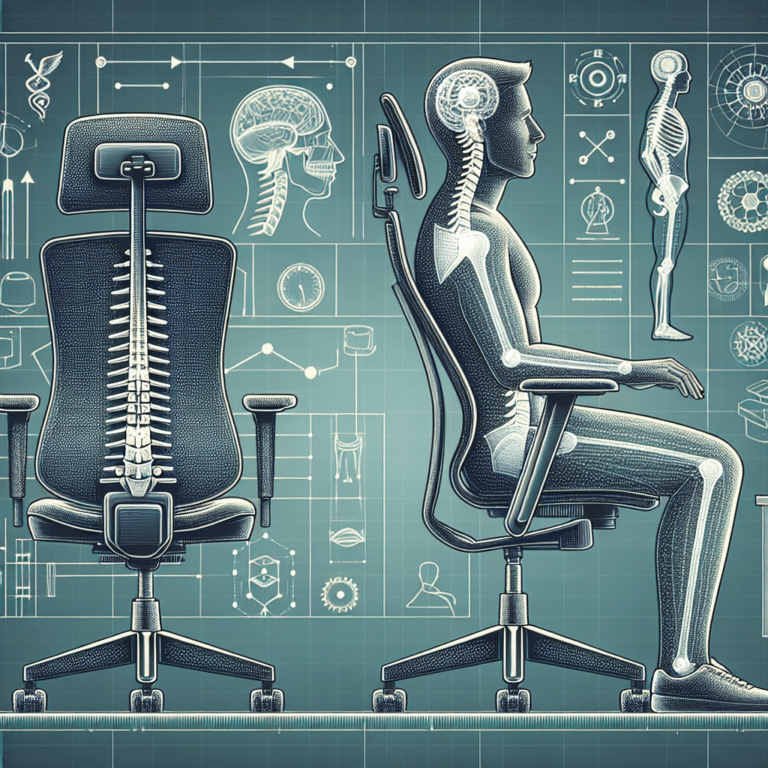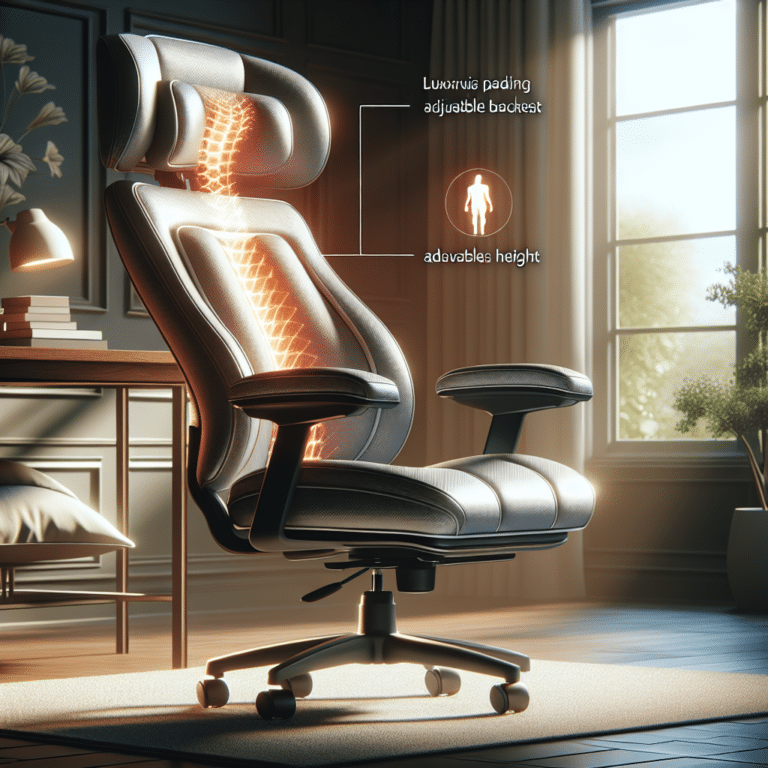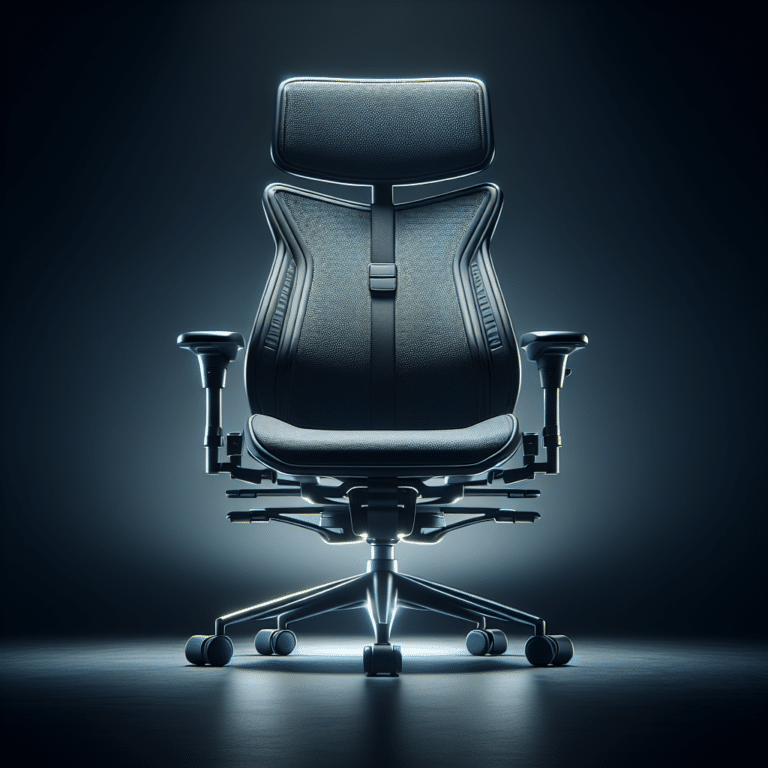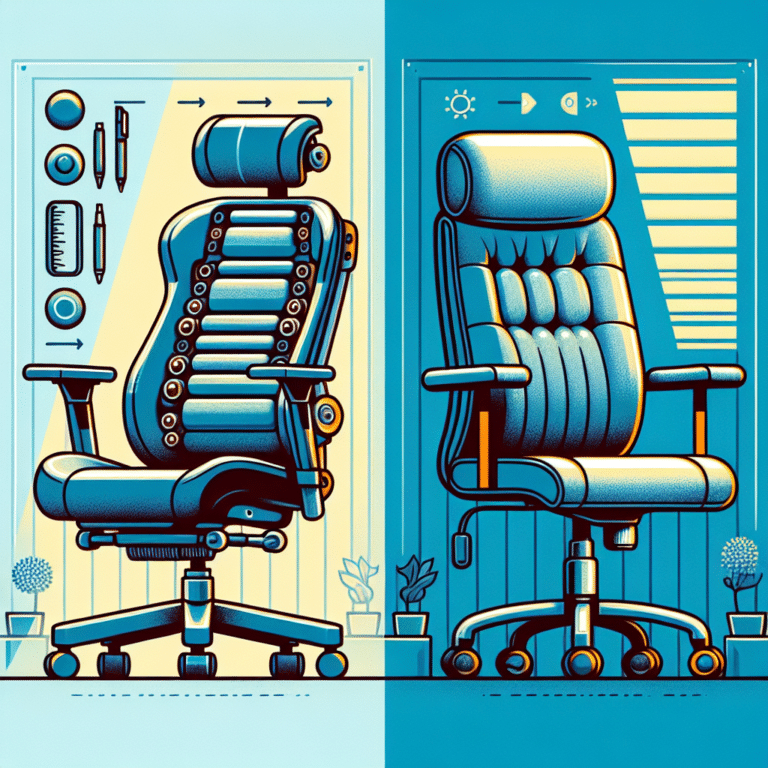How to Choose an Ergonomic Chair for Neck and Shoulder Pain: Expert Tips
If you spend a lot of time sitting at a desk, you may experience neck and shoulder pain or discomfort. This can be caused by poor posture, improper positioning, or an uncomfortable chair. Fortunately, choosing an ergonomic chair can help alleviate these issues and provide a more comfortable and supportive seating experience.
Ergonomics is the science of designing products and work environments to be safe, comfortable, and efficient for human use. When it comes to chairs, ergonomic design can help reduce the risk of musculoskeletal disorders and improve overall comfort and productivity. In this article, we’ll explore the key features to look for in an ergonomic chair and how to properly adjust it to fit your body and reduce neck and shoulder pain.
Key Takeaways
- Ergonomics is the science of designing products and work environments to be safe, comfortable, and efficient for human use.
- An ergonomic chair can help reduce the risk of musculoskeletal disorders and improve overall comfort and productivity.
- When selecting an ergonomic chair, it’s important to consider key features such as adjustability, lumbar support, and armrests, and to properly adjust the chair to fit your body.
Understanding Ergonomics and Its Importance
When it comes to choosing an ergonomic chair for neck and shoulder pain, it’s important to understand what ergonomics is and why it’s important. Ergonomics is the science of designing and arranging objects to optimize human well-being and performance. In the context of chairs, ergonomics involves designing chairs that support the body in a way that reduces the risk of injury and discomfort.
Poor ergonomics can lead to a range of issues, including neck and shoulder pain, back pain, and carpal tunnel syndrome. This is why it’s important to choose an ergonomic chair that is designed to support your body properly and reduce the risk of injury.
When choosing an ergonomic chair, there are several factors to consider, including:
- Adjustability: Look for a chair that is adjustable in terms of height, seat depth, and armrests. This will allow you to customize the chair to your body and ensure that you are sitting in a comfortable and supportive position.
- Lumbar support: A chair with good lumbar support will help to maintain the natural curve of your spine and reduce the risk of lower back pain.
- Seat cushioning: Look for a chair with a cushioned seat that provides adequate support and comfort.
- Material: Choose a chair made from a breathable material that will keep you cool and comfortable during long periods of sitting.
By understanding the importance of ergonomics and choosing an ergonomic chair that is designed to support your body properly, you can reduce the risk of neck and shoulder pain and other issues associated with poor posture and ergonomics.
Anatomy of an Ergonomic Chair

When choosing an ergonomic chair for neck and shoulder pain, it’s important to understand the different components that make up a good chair. Here are the key features to look for:
Adjustable Headrest
An adjustable headrest is a crucial component of an ergonomic chair, as it helps support your neck and prevent strain. Look for a headrest that can be adjusted both vertically and horizontally to fit your body size and shape.
Lumbar Support
Lumbar support is another important feature of an ergonomic chair. It helps support your lower back and maintain the natural curve of your spine. Look for a chair with adjustable lumbar support, so you can find the perfect position for your body.
Backrest
The backrest of an ergonomic chair should be adjustable and provide support for your entire back. Look for a chair with a backrest that can be tilted and locked into different positions, so you can find the perfect angle for your body.
Armrests
Armrests are another important component of an ergonomic chair, as they help support your arms and prevent strain in your shoulders and neck. Look for a chair with adjustable armrests that can be moved up and down, as well as in and out, to fit your body.
Seat Depth and Width
The seat of an ergonomic chair should be deep enough to allow you to sit with your back against the backrest and your feet flat on the ground. Look for a chair with adjustable seat depth and width, so you can find the perfect fit for your body.
By understanding the anatomy of an ergonomic chair and what features to look for, you can choose a chair that will help alleviate your neck and shoulder pain and promote good posture.
Identifying Neck and Shoulder Pain Triggers
Before you start looking for an ergonomic chair to alleviate your neck and shoulder pain, it’s important to identify the triggers that cause your discomfort. Here are some common triggers that you should be aware of:
Poor Posture
Poor posture is one of the most common causes of neck and shoulder pain. If you spend a lot of time sitting in front of a computer, it’s easy to slouch and hunch over your keyboard. This puts a lot of strain on your neck and shoulders, which can lead to pain and discomfort. To avoid this, make sure you sit up straight and keep your shoulders relaxed.
Repetitive Motions
Repetitive motions can also cause neck and shoulder pain. If you perform the same task over and over again, such as typing or using a mouse, you may be putting too much strain on your neck and shoulders. To avoid this, take frequent breaks and stretch your neck and shoulders.
Incorrect Monitor Height
If your monitor is too high or too low, it can cause neck and shoulder pain. You should position your monitor so that the top of the screen is at or slightly below eye level. This will help you maintain good posture and reduce strain on your neck and shoulders.
Lack of Movement
If you sit for long periods of time without moving, it can cause neck and shoulder pain. Make sure you take frequent breaks and move around. You can also do some simple exercises, such as shoulder rolls and neck stretches, to help alleviate tension in your neck and shoulders.
By identifying the triggers that cause your neck and shoulder pain, you can take steps to avoid them and reduce your discomfort. An ergonomic chair can also help alleviate your pain by providing proper support and encouraging good posture.
Key Features to Look for in an Ergonomic Chair

If you are suffering from neck and shoulder pain, choosing the right ergonomic chair can make all the difference. Here are some key features to look for when selecting an ergonomic chair:
Adjustability
Adjustability is one of the most important features to look for in an ergonomic chair. You want a chair that can be adjusted to fit your body perfectly. Look for chairs that have adjustable seat height, armrest height, and lumbar support. The ability to adjust the chair’s height will allow you to sit at the right height for your desk, while adjustable armrests will help you avoid shoulder strain. Lumbar support will help you maintain the natural curve of your spine and reduce strain on your neck and shoulders.
Material and Padding
The material and padding of an ergonomic chair can make a big difference in your comfort level. Look for chairs that have breathable materials that will help keep you cool and comfortable throughout the day. Chairs with memory foam padding can also provide additional support and comfort. You should also consider the durability of the chair’s materials, as you want a chair that will last for years to come.
Swivel and Movement
A chair with a swivel base and smooth movement will allow you to easily move around your workspace without straining your neck and shoulders. Look for chairs that have a 360-degree swivel base and smooth-rolling casters. This will allow you to move around your workspace without having to strain your neck and shoulders to turn or move the chair.
By looking for these key features in an ergonomic chair, you can find a chair that will help reduce your neck and shoulder pain and improve your overall comfort while sitting at your desk.
How to Properly Adjust Your Chair
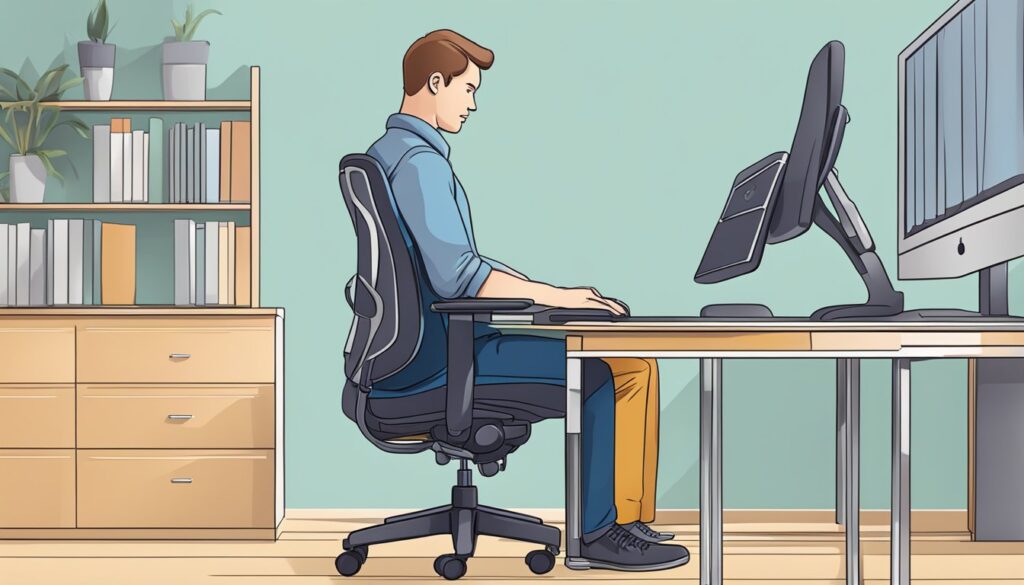
To ensure that your ergonomic chair is properly adjusted, follow these steps:
- Adjust the height of the chair: Your chair should be adjusted to the height of your desk or workstation. You should be able to sit with your feet flat on the floor and your knees at a 90-degree angle. Adjust the height of the chair accordingly.
- Adjust the backrest: The backrest of your chair should be adjusted to support the natural curve of your spine. Adjust the backrest so that it fits snugly against your lower back. This will help to relieve pressure on your spine and prevent lower back pain.
- Adjust the armrests: The armrests of your chair should be adjusted so that your arms are at a comfortable angle. Adjust the armrests so that your elbows are at a 90-degree angle and your shoulders are relaxed.
- Adjust the lumbar support: Some ergonomic chairs come with lumbar support that can be adjusted. Adjust the lumbar support so that it fits snugly against your lower back. This will help to relieve pressure on your spine and prevent lower back pain.
- Adjust the seat depth: The seat depth of your chair should be adjusted so that you can sit with your back against the backrest and your feet flat on the floor. Adjust the seat depth so that there is a small gap between the back of your knees and the front of the seat.
Remember, properly adjusting your ergonomic chair is crucial to preventing neck and shoulder pain. Take the time to adjust your chair properly and you’ll be able to work comfortably and pain-free.
Ergonomic Chair Recommendations
If you’re suffering from neck and shoulder pain, investing in an ergonomic chair can make a world of difference. Here are our top recommendations for ergonomic chairs that can help alleviate your pain and improve your posture.
High-End Ergonomic Chairs
When it comes to high-end ergonomic chairs, there are a few brands that stand out above the rest. These chairs are designed with advanced features and premium materials to provide maximum comfort and support.
Herman Miller Aeron Chair
The Herman Miller Aeron Chair is a classic in the world of ergonomic chairs. It features a mesh backrest and seat that provide excellent breathability and support. The chair also has adjustable armrests, lumbar support, and tilt tension control. While it is on the pricier side, the Aeron Chair is a great investment for anyone looking for a high-quality ergonomic chair.
Steelcase Gesture Chair
The Steelcase Gesture Chair is another top-of-the-line ergonomic chair. It has a unique design that allows it to adjust to a wide range of body types and sitting positions. The chair also features adjustable armrests, lumbar support, and tilt tension control. Its premium materials and advanced features make it a great choice for anyone looking for a top-quality ergonomic chair.
Budget-Friendly Options
If you’re on a tighter budget, there are still plenty of great ergonomic chairs available. These chairs may not have all the bells and whistles of their high-end counterparts, but they still provide excellent support and comfort.
Duramont Ergonomic Office Chair
The Duramont Ergonomic Office Chair is a great budget-friendly option. It has a breathable mesh backrest and adjustable lumbar support to help relieve neck and shoulder pain. The chair also features adjustable armrests and tilt tension control. While it may not have all the advanced features of more expensive chairs, the Duramont is still a great choice for anyone on a budget.
Hbada Ergonomic Office Chair
The Hbada Ergonomic Office Chair is another affordable option that provides excellent support and comfort. It has a mesh backrest and seat that provide good breathability and support. The chair also features adjustable armrests and lumbar support. While it may not have all the advanced features of more expensive chairs, the Hbada is a great choice for anyone looking for a budget-friendly ergonomic chair.
Additional Accessories and Considerations
When selecting an ergonomic chair to alleviate neck and shoulder pain, there are a few additional accessories and considerations to keep in mind. These can help optimize your sitting posture and reduce discomfort.
Footrests
If your feet cannot rest comfortably on the ground while sitting in your ergonomic chair, consider using a footrest. A footrest can help support your feet and improve your posture by keeping your knees at a 90-degree angle. This can help reduce pressure on your lower back and improve circulation in your legs.
Desk Setup
In addition to selecting an ergonomic chair, it is important to consider your desk setup. Your desk should be at a height that allows your arms to rest comfortably on the surface while typing or using a mouse. If your desk is too high or too low, it can cause strain on your neck, shoulders, and back.
Posture Correctors
If you find yourself slouching or hunching forward while sitting, a posture corrector may be a helpful accessory. Posture correctors can help train your muscles to maintain proper alignment and reduce strain on your neck and shoulders. However, it is important to use them in moderation and not rely on them as a long-term solution.
By considering these additional accessories and adjustments to your desk setup, you can further optimize your sitting posture and reduce discomfort while using your ergonomic chair.
Maintenance Tips for Ergonomic Chairs
Once you have chosen the right ergonomic chair for your neck and shoulder pain, it’s important to maintain it properly to ensure it lasts as long as possible. Here are some maintenance tips for ergonomic chairs:
1. Clean the Chair Regularly
Cleaning your ergonomic chair on a regular basis will help keep it in good condition. Use a soft cloth or sponge to wipe down the chair, and avoid using harsh chemicals that could damage the material.
2. Adjust the Chair to Your Body
It’s important to adjust your ergonomic chair to fit your body properly. Make sure the height and depth of the seat are adjusted so that your feet are flat on the floor and your knees are at a 90-degree angle. Adjust the armrests so that your arms are relaxed and your shoulders are not hunched up.
3. Check the Chair’s Components
Check the chair’s components regularly to ensure they are functioning properly. This includes the wheels, gas cylinder, and tilt mechanism. If any components are damaged or not functioning properly, replace them immediately to avoid further damage to the chair.
4. Use a Chair Mat
If you have a carpeted floor, use a chair mat to protect your chair’s wheels. This will prevent the wheels from getting stuck in the carpet and will also protect your carpet from damage.
5. Store the Chair Properly
If you need to store your ergonomic chair, make sure you do so properly. Store it in a dry, cool place away from direct sunlight. Cover it with a protective cover to prevent dust and debris from accumulating on the chair.
By following these maintenance tips, you can ensure that your ergonomic chair for neck and shoulder pain lasts as long as possible and continues to provide you with the support you need.
Frequently Asked Questions
What are the key features to look for in an office chair to alleviate neck and shoulder pain?
When choosing an office chair to alleviate neck and shoulder pain, it’s important to look for chairs that offer adjustable features. The chair should have adjustable height, armrests, and lumbar support. The seat should be adjustable, and the chair should have a tilt function to allow you to change positions throughout the day. A chair with a headrest can also help to support your neck and reduce tension.
How does an ergonomic chair reduce the risk of posture-related neck and shoulder issues?
Ergonomic chairs are designed to support your body’s natural posture, which can help to reduce the risk of posture-related neck and shoulder issues. These chairs are designed to provide support where you need it most, such as in the lumbar region, to help you maintain proper posture. They also often have adjustable features, which allow you to customize the chair to your body’s specific needs.
What are the benefits of a saddle chair for maintaining proper posture and reducing pain?
Saddle chairs are designed to help you maintain proper posture while sitting. They have a unique design that allows your hips to sit in a more natural position, which can help to reduce pressure on your lower back. This can help to reduce pain and discomfort in the neck and shoulders. Saddle chairs also encourage movement, which can help to prevent stiffness and tension.
Can the use of ergonomic chairs significantly improve upper back pain, and how?
The use of ergonomic chairs can significantly improve upper back pain by providing support where you need it most. These chairs are designed to help you maintain proper posture, which can help to reduce the strain on your upper back muscles. They also often have adjustable features, which allow you to customize the chair to your body’s specific needs.
What adjustments should be made to an office chair to prevent neck and shoulder discomfort during long sitting periods?
To prevent neck and shoulder discomfort during long sitting periods, it’s important to make several adjustments to your office chair. First, adjust the height of the chair so that your feet are flat on the ground. Adjust the armrests so that your shoulders are relaxed and your elbows are at a 90-degree angle. Adjust the lumbar support so that it supports the natural curve of your spine. Finally, adjust the tilt of the chair to allow you to change positions throughout the day.
How does seat design and material affect neck and shoulder health in office chairs?
Seat design and material can affect neck and shoulder health in office chairs by providing support and reducing pressure points. A chair with a contoured seat can help to distribute your weight evenly, reducing pressure on your hips and lower back. The material of the seat should be breathable and comfortable to prevent sweating and discomfort. A chair with a waterfall edge can also help to reduce pressure on your thighs and improve circulation.



